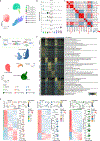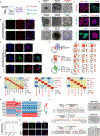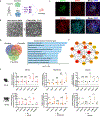Dissecting embryonic and extraembryonic lineage crosstalk with stem cell co-culture
- PMID: 38052213
- PMCID: PMC10916932
- DOI: 10.1016/j.cell.2023.11.008
Dissecting embryonic and extraembryonic lineage crosstalk with stem cell co-culture
Abstract
Embryogenesis necessitates harmonious coordination between embryonic and extraembryonic tissues. Although stem cells of both embryonic and extraembryonic origins have been generated, they are grown in different culture conditions. In this study, utilizing a unified culture condition that activates the FGF, TGF-β, and WNT pathways, we have successfully derived embryonic stem cells (FTW-ESCs), extraembryonic endoderm stem cells (FTW-XENs), and trophoblast stem cells (FTW-TSCs) from the three foundational tissues of mouse and cynomolgus monkey (Macaca fascicularis) blastocysts. This approach facilitates the co-culture of embryonic and extraembryonic stem cells, revealing a growth inhibition effect exerted by extraembryonic endoderm cells on pluripotent cells, partially through extracellular matrix signaling. Additionally, our cross-species analysis identified both shared and unique transcription factors and pathways regulating FTW-XENs. The embryonic and extraembryonic stem cell co-culture strategy offers promising avenues for developing more faithful embryo models and devising more developmentally pertinent differentiation protocols.
Keywords: ECM signaling; embryonic stem cell; extraembryonic endoderm stem cell; lineage crosstalk; monkey; mouse; trophoblast stem cell.
Copyright © 2023 Elsevier Inc. All rights reserved.
Conflict of interest statement
Declaration of interests Y.W., L.Y., T.T., and J.W. are inventors on a patent application (applied through the Board of Regents of The University of Texas System, application number 63/488,401) entitled “Methods For the Derivation Culture Of Embryonic and Extra-Embryonic Stem Cells” arising from this work.
Figures







Update of
-
Dissecting embryonic and extra-embryonic lineage crosstalk with stem cell co-culture.bioRxiv [Preprint]. 2023 Mar 8:2023.03.07.531525. doi: 10.1101/2023.03.07.531525. bioRxiv. 2023. Update in: Cell. 2023 Dec 21;186(26):5859-5875.e24. doi: 10.1016/j.cell.2023.11.008. PMID: 36945498 Free PMC article. Updated. Preprint.
References
MeSH terms
Grants and funding
LinkOut - more resources
Full Text Sources
Molecular Biology Databases

